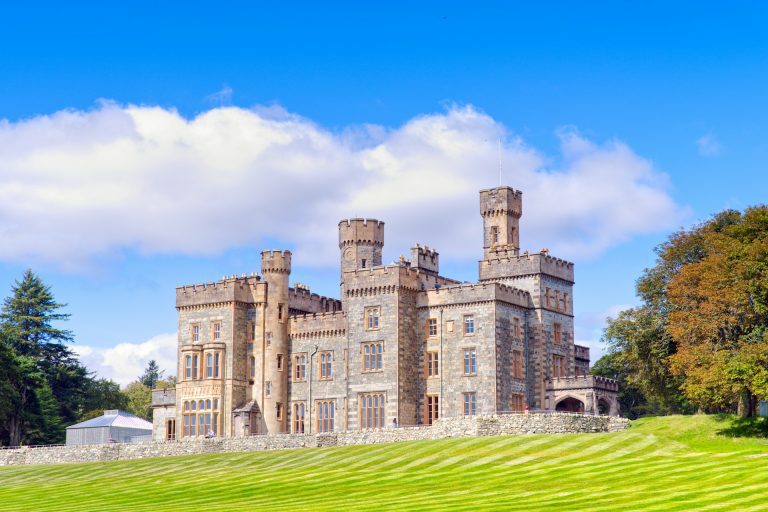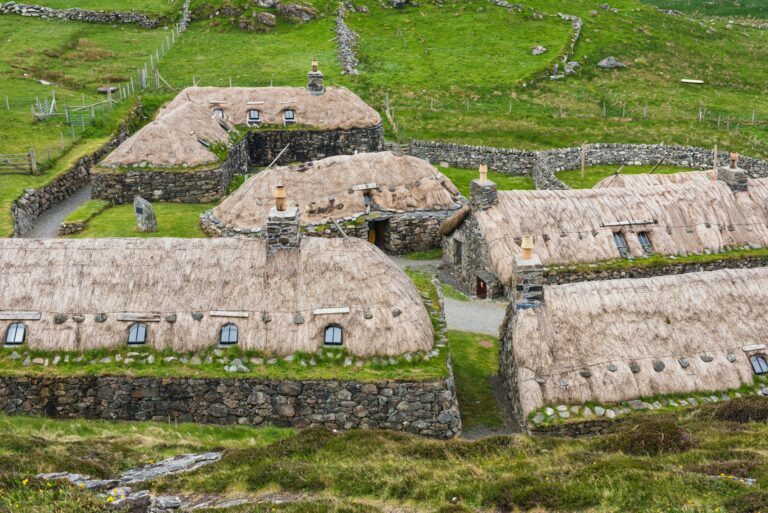The Isle of Lewis
The Isle of Lewis, the largest island in Scotland’s Outer Hebrides, is a land of ancient history, dramatic landscapes, and rich Gaelic culture. With its sweeping moorlands, rugged coastline, and tranquil beaches, Lewis offers a unique mix of natural beauty and cultural heritage
Gearrannan Blackhouse Village
Stornoway
Callanish Standing Stones
Lews Castle
The History of the Isle of Lewis
Lewis is steeped in history, with evidence of human habitation dating back over 5,000 years. From prehistoric standing stones to Norse influences and centuries of Gaelic culture, the island’s past is as diverse as its landscape.
One of the most famous historical sites on Lewis is the Callanish Standing Stones, a circle of megalithic stones that date back to around 3000 BC. These enigmatic stones are older than Stonehenge and continue to captivate visitors with their mystery and alignment with lunar cycles. The Callanish Stones are a reminder of the ancient civilizations that once called this island home.
The Vikings also left their mark on Lewis, having settled on the island during the 9th century. Norse place names and archaeological finds reflect their influence on the island’s history. Later, Lewis became a stronghold of the Gaelic-speaking clan system, which has shaped the island’s culture for centuries.
Things to Do on the Isle of Lewis
1. Explore the Callanish Standing Stones
No visit to Lewis is complete without seeing the Callanish Standing Stones. Located near the village of Callanish, these ancient stones are thought to have been used for astronomical or ceremonial purposes. The main stone circle is accompanied by several smaller satellite circles, all with their own unique formations. Visiting at sunrise or sunset can add a magical dimension to the experience, as the stones cast long shadows over the surrounding landscape.
2. Discover the Gearrannan Blackhouse Village
For a glimpse into traditional Hebridean life, head to Gearrannan Blackhouse Village. This restored village consists of several traditional stone cottages, known as blackhouses, which were lived in by crofting families until the mid-20th century. Today, the village operates as a heritage site, where you can explore the old homes, learn about weaving Harris Tweed, and even stay overnight in one of the blackhouses.
3. Stornoway: The Heart of Lewis
Stornoway, the main town and the largest settlement on the island, is a hub of activity on Lewis. As the capital of the Western Isles, it offers a blend of modern conveniences and traditional charm. The town is home to Lews Castle, a 19th-century mansion surrounded by beautiful woodland and gardens. The castle now houses a museum where you can learn about island life, including the famous Lewis Chessmen, medieval chess pieces carved from walrus ivory that were discovered on the island.
Stornoway is also known for its food scene, especially its Stornoway black pudding, a type of blood sausage that has earned Protected Geographical Indicator (PGI) status.
4. Beaches and Outdoor Activities
The Isle of Lewis is home to some of the most stunning beaches in Scotland. It’s the perfect place for a peaceful walk or to simply take in the views of the Harris mountains in the distance.
A popular beach is Uig, located near the site where the Lewis Chessmen were discovered. This beach is known for its pristine sands and rugged cliffs, offering a perfect spot for picnics, beachcombing, and photography.
Outdoor enthusiasts will also find plenty to do on Lewis. There are numerous opportunities for hiking, birdwatching, cycling, and kayaking. The island’s landscape is dotted with lochs, peat bogs, and rolling hills, making it ideal for those who want to immerse themselves in nature.
5. Arnol Blackhouse
Another iconic blackhouse, located in the village of Arnol, offers a fascinating look at how Hebridean families lived. Arnol Blackhouse No. 42 is preserved in its original condition, with its peat fire still burning and traditional furnishings in place. This museum provides a hands-on history lesson, complete with the smells and sounds of a 19th-century Hebridean home.
6. Experience Gaelic Culture
Gaelic language and culture are alive and thriving on the Isle of Lewis. Many locals still speak Gaelic as their first language, and traditional music, storytelling, and dancing are part of everyday life. Visiting during one of the island’s festivals, such as the Hebridean Celtic Festival held in Stornoway, offers the chance to experience Gaelic music and culture firsthand.
Practical Tips for Visiting
Getting There: The Isle of Lewis is accessible by ferry from Ullapool on the Scottish mainland, with the ferry arriving in Stornoway. There are also flights from Glasgow, Edinburgh, and Inverness to Stornoway Airport.
Accommodation: Lewis offers a range of accommodations, from hotels and guesthouses to self-catering cottages and campsites. For a unique stay, consider booking one of the traditional blackhouses in Gearrannan.
Best Time to Visit: Summer is the best time to visit, with long days, mild temperatures, and the possibility of good weather. However, spring and autumn can also be beautiful, and you’ll have fewer crowds. The winter months offer a quieter, more atmospheric experience, though weather conditions can be harsher.
Why Visit the Isle of Lewis?
The Isle of Lewis offers a captivating blend of history, culture, and natural beauty. Whether you’re exploring its ancient sites, wandering its beaches, or immersing yourself in Gaelic traditions, the island provides a unique and enriching travel experience. Its remote location, far from the hustle and bustle of modern life, makes Lewis a perfect destination for those seeking a peaceful retreat into Scotland’s wild and rugged landscapes.
With its deep-rooted heritage and stunning scenery, the Isle of Lewis promises visitors a journey back in time, where the rhythms of nature and traditional island life remain at the heart of the experience.
Lewis blog ...
Would you like to share your Scotland stories?
Why not check out my travel resources or get in touch with your experiences





